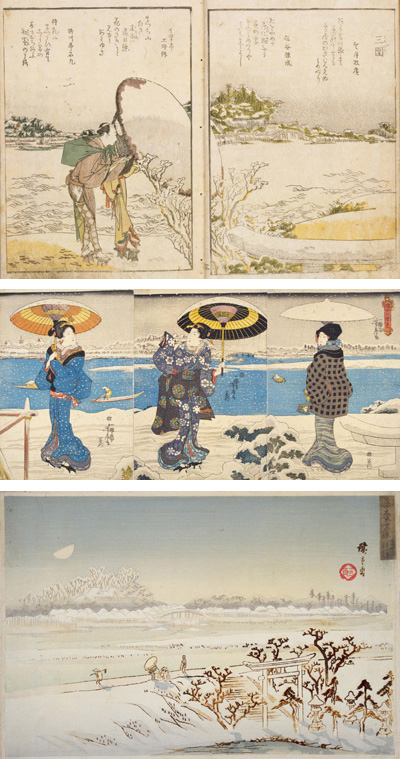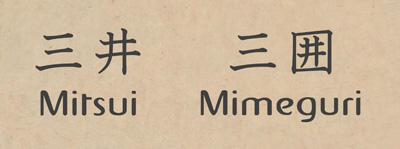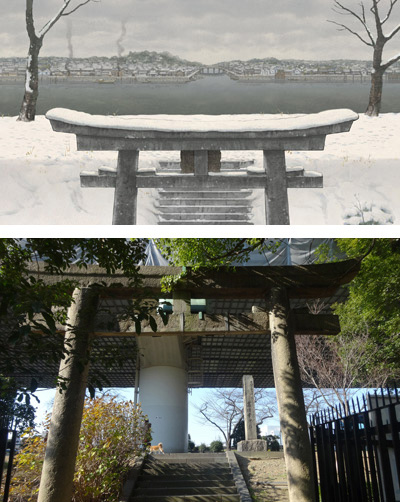History Special 5: A Shrine under the Snow
In all interviews, Keiichi Hara explains that in the making of Miss Hokusai, all he did was nothing more than faithfully transposing Hinako Sugiura's comic book Sarusuberi as it was. Scriptwriter Miho Maruo wouldn't answer differently, pointing out how the original dialogue lines were so beautiful, that she simply inserted them into the script. However, reading the manga would immediately reveal the subtle and painstaking labour of love that has been carried out in adapting the source material.
Among the several contributions made by Hara and Maruo, the snow sequence -originally not in the comic book- is a little gem within the beauty of the film. The masterful animations by Toshiyuki Inoue. The delicate colour palette in Hiroshi Ono's backdrops. The tender interaction between O-Ei and O-Nao. The deeply touching flashback depicting O-Ei's childhood, that delivers an entire world of conflicting emotions without using a single dialogue line, is a shining example of Maruo's inspired film writing. However, this almost magical sequence has a quite real setting: Mimeguri Shrine, on the east bank of the Sumida River.

The shrine was -and still is- located on a level below the river bank, and anyone strolling along the river had to walk down several steps in order to reach the compound. With most Shinto shrines standing on top of hills and mounds, this gave Mimeguri an immediately recognizable feature, with its torii (gate) timidly peeking out at street level instead of its institutional towering role at the entrance of the sacred compound. Such unusual trait couldn't possibly fail to capture the curiosity of many artists, who intentionally depicted the shrine from road perspective, with only a tiny glimpse of the torii popping up from the lower corner of the picture, hinting at a famous location rather than openly displaying it, in pure Edo fashion.

Hokusai, who lived his entire life on the same side of the river, was also personally involved: in 1799, on the occasion of the traditional public display of the shrine holy relics, he was asked to paint twelve big paper lanterns. Not only he made the lanterns, but he went further and created a large size painting as a personal donation. Sadly, all artworks, that according to accounts of the time were very popular among the visitors in pilgrimage, are now lost.
On a side note, Mimeguri Shrine was also very dear to the Mitsui family, founders and owners of a successful kimono retailer named Echigoya that had been established near Nihonbashi in 1673. Apparently, the shrine was standing northeast of the store, meaning it was covering the nefarious Demon's Gate according to the principles of fēngshuĭ, hence ideally protecting the Mitsuis from any possible bad luck. Furthermore, the Chinese character for "meguri" was written as a well inscribed in a square. As the Chinese character for "well" was also the "i" in the Mitsui name, it somehow symbolized a protective encirclement implemented by the shrine in favour of the family.

It may be argued that the devotion of the Mitsuis for Mimeguri shrine didn't prove completely groundless, as eventually they became a major player of the Meiji Restauration and the modernization of Japan. Furthermore, their Echigoya store business developed into an ubiquitous department store chain known as Mitsukoshi, and into Japan's first private financial institution, namely the Mitsui Bank.
Like in the case of many other relevant spots of the city of Edo, for example Nihonbashi Bridge, modern Japan's rather drastic urbanistic plans have been a bit unkind to Mimeguri, that today appears somehow suffocated by the massive system of elevated roads built to ease the metropolis' endemic traffic problems, and the landscape is radically different from the almost bucolic scenery depicted in the prints of the time. (fp)

(5 - to be continued)
© 2017 fp
© 2014-2015 Hinako Sugiura•MS.HS / Sarusuberi Film Partners

![WORK LIST[DETAILS]](/contents/works/design/images/left_title.gif)



 terms of use
terms of use